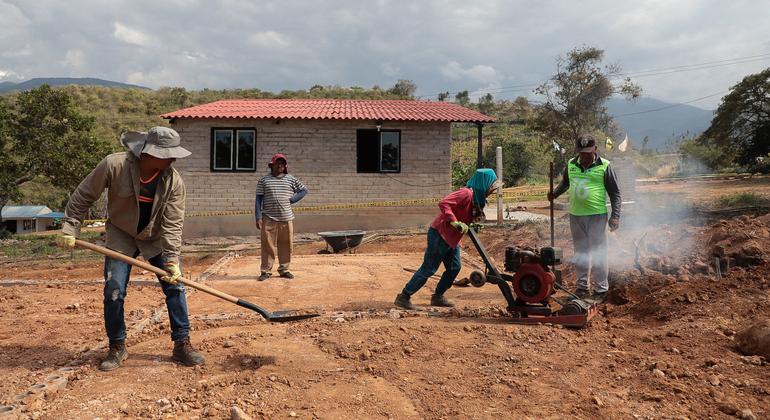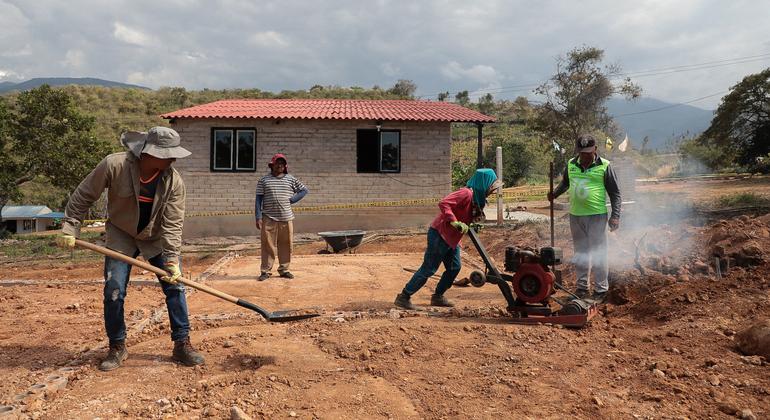
A group of former combatants with the FARC rebel group in Colombia have been reflecting on five years of peace and community building in a locality called Tierra Grata, which translates as “pleasant land”
A pot boils on a wood fire in the open air at a rest spot in the Serranía del Perijá, in the mountainous rural north of Colombia. More than a hundred people, including former combatants from the Revolutionary Armed Forces of Colombia rebel group known as FARC, their families, and local people as well as soldiers of the Colombian National Army, work together on the edge of a precipice.
They are carrying three-inch-diameter hoses over nearly nine kilometers of steep terrain as part of a UN Food and Agriculture Organization (FAO)-supported project to improve water supplies.
It took months of hard work to lift the hose, set it in place, bury it and connect it to a local river which provides a reliable supply of water.
“The most beautiful thing I remember was the way the army, our former adversary, community, former rebels and local authorities worked together, regardless of the past that separated us,” says Yarledys Olaya, an indigenous Barí woman, who spent 20 years fighting for the now disbanded FARC rebel group.
FARC guerillas waged a half century-long civil war against the Colombian authorities, which officially ended with the signing of a historic Final Peace Agreement in 2016.

Marcos Guevara
Yarledys Olaya (left) works alongside other former combatants and local people to laya water pipe.
A new life in a pleasant land
Yarledys Olaya is one of some 13,000 ex-combatants who committed to peace in Colombia and who began new lives in places like Tierra Grata.
“I picture my future here; I picture myself growing old,” she says. “This process has not been easy. In the past we saw our comrades get killed. But personally, it has allowed me to start my family, to be able to spend time with them, and to open my home to my daughters.
“That is why we want to continue building and betting on peace. Not only for the rebels who have been reintegrated into society but for a collective peace for the country.”
In the nearby town of San José de Oriente, local people were afraid that when the ex-combatants came to the region, violence would start again, but minds were changed when they brought just peace and a willingness to work on community projects.
Yarledys Olaya arrived in Tierra Grata in November 2016 aboard a truck together with 120 other guerrillas, most of them armed. She was wearing a camouflage uniform, boots, a black T-shirt, and carried a backpack and a rifle on her shoulder; she covered her face with a green scarf not wanting to be identified.
“There was a lot of mistrust. I felt that we were reserved, surly, and that local people looked at us differently.” It was two months before, the Peace Agreement between the government and the FARC had been signed.
“This was not a personal decision, it was a collective decision,” she says. “I thought, let’s continue but live life in another way. The good thing is that I had no longer had to see my comrades fall, which is normal during a war.”
Monitoring the ceasefire
It was an isolated location; an old farmhouse stood beside dense vegetation, including the native frailejones plant. A piece of land had been cleared to make room to build a reintegration camp; all around, there were Army and Colombian police personnel.

Yarledys Olaya addresses the Tierra Grata Community Action Board of which she is president. , by Marcos Guevara
In a nearby area, the United Nations had erected tents where experts who had monitored the ceasefire would verify the laying down of arms. Between March and September 2017, the UN mission in Colombia received 8,994 weapons from FARC throughout the country including Tierra Grata.
Six months were spent building the camp which provided 158 living quarters. The ex-combatants were supposed to undergo a reintegration process there and then leave for a more permanent location, but most of them had nowhere to go and so stayed.
Daughters from war, and peace
Today, Tierra Grata is a formalized village inhabited by some 300 people, both ex-combatants and family members. Some were born there, and others joined their families.
Yarledys Olaya left her newborn, Yacana, with a relative when she joined FARC and was reunited two months after arriving in Tierra Grata. Two years later she gave birth to another daughter, Yaquelín, one of 65 children, born in the new settlement.
“Yacana is my daughter from the war, and Yaquelín my daughter from peace,” she says.
Yarledys Olaya continues to work on community projects, building permanent structures and bringing water and electricity to the village. “As women during the war, we played a fundamental role,” she says, “and now in this new moment, we are helping to build peace, because we feel that this process is ours; that is why we are willing to contribute our last drop of sweat to this future.”

SDG 16: Peace, Justice and Strong Institutions
- Sustainable Development Goal 16 recognizes that conflict, insecurity, weak institutions and limited access to justice remain a significant threat to sustainable development.
- It aims to reduce all forms of violence and deaths caused by that violence. It focuses on ending the abuse, exploitation, torture and trafficking of children.
- The UN Verification Mission in Colombia was established by the UN Security Council in 2017 to support the peace process in Colombia.
- It has worked closely with national authorities and former combatants to promote progress in reintegration and security-related issues.
